Working from home has transformed how we think about our living spaces. With remote work becoming the new normal we’re all searching for creative ways to blend productivity with comfort in our homes. The living room often becomes the perfect solution for those of us who need a workspace but don’t have a dedicated office.
Creating a functional home office within your living room doesn’t mean sacrificing style or comfort. We’ve discovered that with the right design strategies you can seamlessly integrate a productive workspace into your main living area without it feeling cramped or cluttered.
Whether you’re dealing with a small apartment or simply want to maximize your existing space we’ll show you how to transform any corner of your living room into an inspiring work environment. From clever furniture choices to smart storage answers these ideas will help you create the perfect work-life balance right in your own home.
Create a Dedicated Zone With Room Dividers
Room dividers transform your living room office space by establishing clear boundaries between work and relaxation areas. We can maintain the open feel of our living room while creating a distinct workspace that helps us stay focused during business hours.
Use Folding Screens for Flexible Separation
Folding screens offer the most versatile solution for creating temporary office boundaries in our living space. We can easily move these portable dividers throughout the day, setting them up during work hours and folding them away when we want our full living room back.
Japanese-style screens with natural wood frames bring warmth to our workspace while maintaining visual appeal. Canvas panels provide excellent privacy without blocking natural light completely. Fabric screens in neutral tones like beige or gray complement most living room color schemes seamlessly.
Three-panel screens work best for standard living rooms, creating a cozy alcove without overwhelming the space. We can position these dividers at angles to maximize our desk area while keeping pathways clear for family members.
Install Sliding Barn Doors for Modern Appeal
Sliding barn doors create a striking architectural feature while providing complete workspace separation when needed. We mount these doors on ceiling tracks, allowing them to glide smoothly across our designated office area without taking up valuable floor space.
Reclaimed wood doors add rustic charm to contemporary living rooms, while painted barn doors in crisp white or charcoal create clean, modern lines. Glass panel barn doors maintain visual connection between spaces while reducing noise from family activities.
Hardware finishes in matte black or brushed bronze complement most interior design styles. We can install soft-close mechanisms to prevent slamming and ensure quiet operation during video calls or focused work sessions.
Position Tall Bookshelves as Natural Dividers
Tall bookshelves serve dual purposes as room dividers and essential office storage in our living room workspace. We strategically place these vertical elements to create separation without completely closing off our work area from the rest of the room.
Open-back bookcases maintain airflow and light circulation while providing display space for books, plants, and decorative objects. Ladder-style shelving units offer modern industrial appeal with minimal visual weight. Built-in shelving creates permanent workspace definition while maximizing storage capacity.
Six to eight-foot tall units provide adequate privacy for our desk area without making our living room feel cramped. We can mix books with storage baskets, office supplies, and personal items to create an organized, visually interesting backdrop for our home office zone.
Maximize Corner Spaces for Compact Workstations
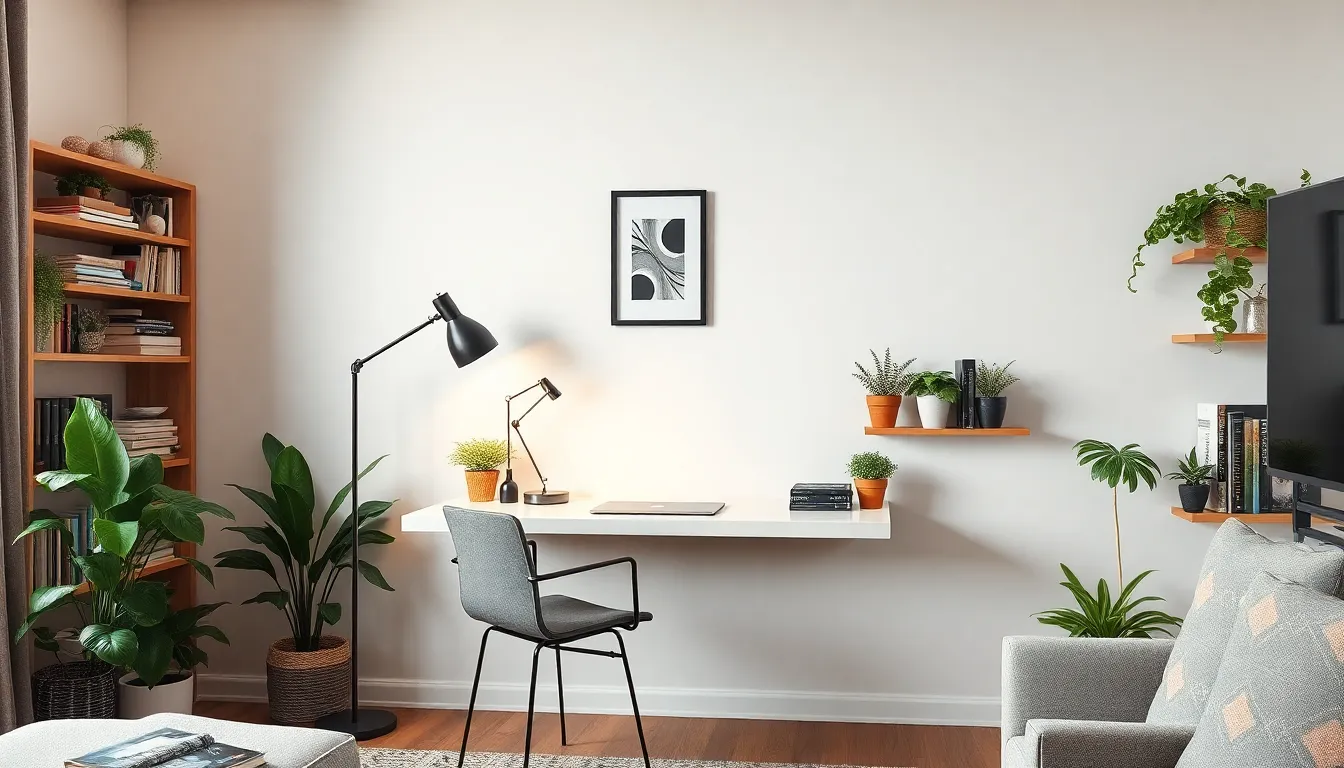
Corners often remain underutilized in our living rooms, yet they offer prime real estate for creating efficient home office spaces. We can transform these neglected areas into highly functional workstations that seamlessly blend with our existing decor.
Transform Dead Corners Into Productive Areas
Converting unused corners into productive workspace starts with recognizing their potential as intimate work zones. We can establish a cozy reading nook with a comfortable chair and floor lamp that doubles as a quiet workspace for focused tasks. Plants become natural productivity enhancers when we add them to corner areas, creating an inspiring environment that boosts our mood and concentration. Small side tables tucked into corners provide additional surface space for notebooks, coffee cups, or essential office supplies. Corner positioning naturally creates a sense of privacy and focus that’s often missing in open living room layouts.
Install Floating Corner Desks to Save Floor Space
Floating corner desks revolutionize small living room layouts by eliminating bulky furniture legs and creating seamless integration with our existing decor. We mount these space saving answers directly to the wall, freeing up valuable floor space while maintaining a clean, modern aesthetic. Built in storage options within floating desks keep office supplies organized and hidden from view, preserving our living room’s primary function as a gathering space. Custom sizing allows us to maximize every inch of available corner space, creating workstations that fit perfectly into our exact room dimensions. Installation typically requires only basic wall anchors and can support standard computer equipment and daily work essentials.
Add Corner Shelving for Vertical Storage Answers
Vertical storage transforms corners into organizational powerhouses that accommodate books, files, and office equipment without cluttering floor space. We install corner shelving units that fit snugly into tight angles, maximizing storage capacity while maintaining visual appeal throughout our living area. Hidden storage options like corner cabinets or built in drawers conceal office equipment during non working hours, helping us maintain a clutter free environment. Strategic shelf placement creates dedicated zones for different work materials, from reference books on upper shelves to frequently used supplies within easy reach. Multiple shelf configurations allow us to adapt storage answers to our exact work requirements and living room aesthetics.
Incorporate Multi-Functional Furniture Pieces
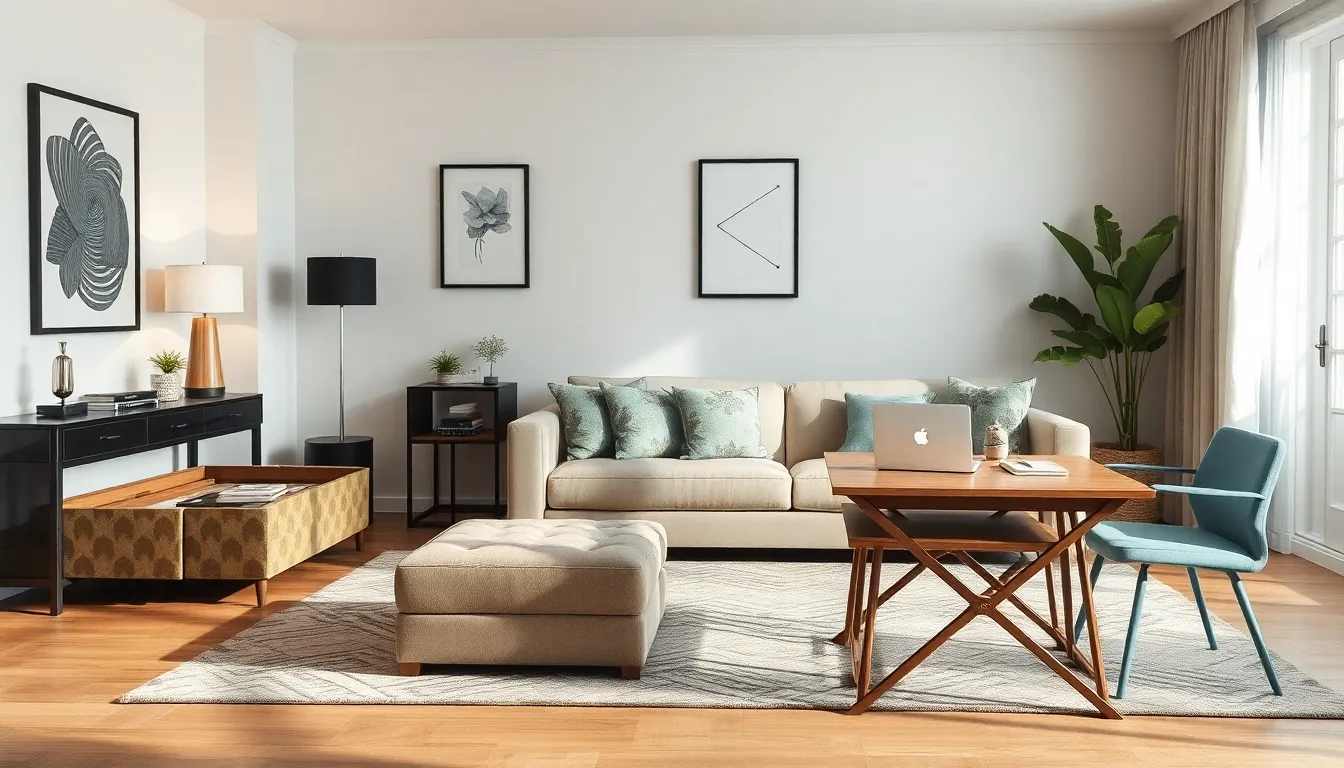
Smart furniture selection transforms living room corners into productive home office spaces while maintaining style and functionality. We can maximize our space efficiency by choosing pieces that serve dual purposes throughout our daily routines.
Choose Ottomans With Hidden Storage Compartments
Ottomans with concealed storage create the perfect balance between seating and organization in our living room offices. These versatile pieces provide additional seating for guests while keeping office supplies, cables, and documents neatly tucked away from view. We can position an ottoman beside our desk area to store frequently used items within arm’s reach.
Storage ottomans help maintain the clutter-free aesthetic that’s essential for both productive work sessions and relaxing evenings. They’re particularly effective when placed near our workspace to hold printer paper, notebooks, and other office essentials that would otherwise create visual chaos in our living areas.
Select Console Tables That Double as Desks
Console tables positioned behind sofas create instant workspace answers without overwhelming our living room’s primary function. We can transform this typically underutilized space into a productive office area that doesn’t interfere with daily relaxation activities. These narrow tables provide adequate surface area for laptops, monitors, and essential office supplies.
Behind the sofa placement allows us to work while still participating in household activities and conversations. Console desk setups maintain clear sightlines throughout the room while establishing a dedicated work zone that feels naturally integrated rather than imposed.
Invest in Nesting Tables for Flexible Workspace Options
Nesting tables offer unmatched flexibility for our home office living room combinations because they adapt to changing daily needs. We can pull out additional surfaces when projects require extra space, then tuck them away to restore our living room’s open feel. These stackable answers work particularly well for temporary tasks like sorting documents or spreading out reference materials.
Flexibility becomes crucial when our living spaces must transition between work mode and entertainment areas throughout the day. Nesting tables allow us to customize our workspace size based on current projects while maintaining the room’s primary social function during off hours.
Design Behind-the-Sofa Office Arrangements

We’ve discovered that the space behind our sofa presents one of the most effective opportunities for creating a dedicated workspace without disrupting our living room’s primary function. These strategic arrangements maximize underutilized areas while maintaining seamless flow between work and relaxation zones.
Position a Narrow Desk Against the Sofa Back
Narrow console-style desks placed directly against the sofa back create defined workspaces while preserving valuable floor space in our living areas. This positioning keeps our office setup out of the main focal points yet maintains easy accessibility for daily work tasks. We can choose desks between 12-16 inches deep to ensure they don’t overwhelm the space while providing adequate surface area for laptops, documents, and essential office supplies.
Storage answers become crucial in this arrangement since we need to keep our workspace organized without cluttering the living room’s aesthetic. Built-in shelving or nearby cabinetry helps maintain a clean desk surface while keeping work materials within reach. Lighting positioned above or beside the desk ensures adequate illumination for productivity without disrupting the room’s ambient atmosphere.
Create a Console Table Workspace Setup
Console tables serve dual purposes as stylish furniture pieces and functional workstations when positioned behind our sofas. We can select console tables that complement our existing living room decor while providing sufficient workspace for laptops, lamps, and office essentials. This approach blends our workspace seamlessly with the room’s design elements rather than creating a stark contrast.
Decorative elements on the console table help maintain the living room’s aesthetic while concealing work materials. We can incorporate stylish storage boxes, attractive lamp bases, or small plants to create visual interest while keeping our workspace organized. The key lies in choosing console tables with drawers or lower shelves that provide hidden storage for office supplies and documents.
Use Bar-Height Tables for Standing Desk Options
Bar-height or counter-height tables positioned behind our sofas create ergonomic standing workstations that add variety to our work routine. These elevated surfaces typically measure 36-42 inches in height, promoting better posture and reducing the health risks associated with prolonged sitting. We can alternate between standing and sitting throughout our workday by pairing these tables with adjustable bar stools.
Standing desk configurations behind sofas maintain distinct workspace boundaries while integrating naturally into our living room layout. The elevated surface creates a visual separation between work and relaxation areas without requiring permanent room divisions. We can choose sleek, minimalist designs that enhance our room’s modern aesthetic while providing the ergonomic benefits of standing workstations.
Utilize Wall-Mounted Solutions for Space Efficiency
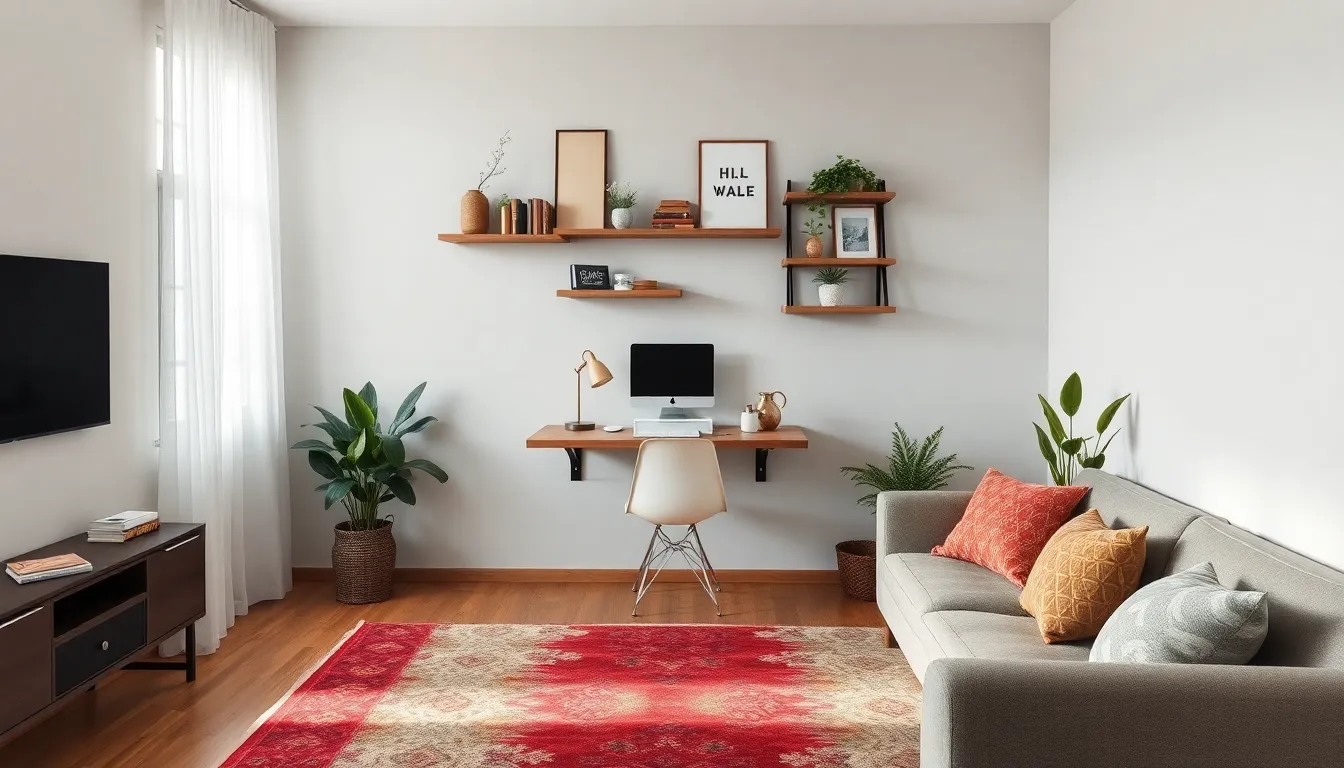
Wall-mounted answers offer the perfect balance between functionality and style when creating a home office in your living room. These vertical storage and workspace options help preserve precious floor space while maintaining the room’s primary purpose.
Install Floating Desks to Maximize Floor Space
Floating desks provide a sleek and modern workspace solution that doesn’t overwhelm your living room’s aesthetic. We recommend installing these wall-mounted surfaces at standard desk height to create an efficient work zone without sacrificing valuable floor area. The streamlined design allows for better traffic flow around furniture while maintaining a clean, uncluttered appearance.
These space-saving answers work particularly well in smaller living rooms where every square foot counts. You can position floating desks along unused wall sections or even in alcoves to create dedicated work areas. The minimal footprint ensures your living space remains open and inviting while providing essential workspace functionality.
Mount Fold-Down Desks for Occasional Use
Fold-down desks offer ultimate flexibility for those who need workspace only during exact hours. We suggest mounting these convertible surfaces at eye level when folded up, allowing them to blend seamlessly with your wall decor. The compact design transforms from a sleek wall panel into a functional workspace within seconds.
This solution works exceptionally well for living rooms that serve multiple purposes throughout the day. During work hours, you can easily fold down the desk to create an instant office space. When it’s time to relax or entertain guests, simply fold the desk back up to restore your living room’s original layout and aesthetic.
Add Wall-Mounted Shelving for Office Supplies
Wall-mounted shelving keeps your office supplies organized and easily accessible without cluttering your living space. We recommend installing floating shelves at varying heights to create visual interest while maximizing storage capacity. These vertical storage answers help maintain a clean workspace by keeping essential items within arm’s reach.
Strategic placement of wall-mounted shelving near your desk area ensures optimal organization and workflow. You can display decorative items alongside office supplies to maintain your living room’s aesthetic appeal. The open design prevents the space from feeling cramped while providing ample storage for books, documents, and work essentials.
Blend Office Elements With Living Room Decor
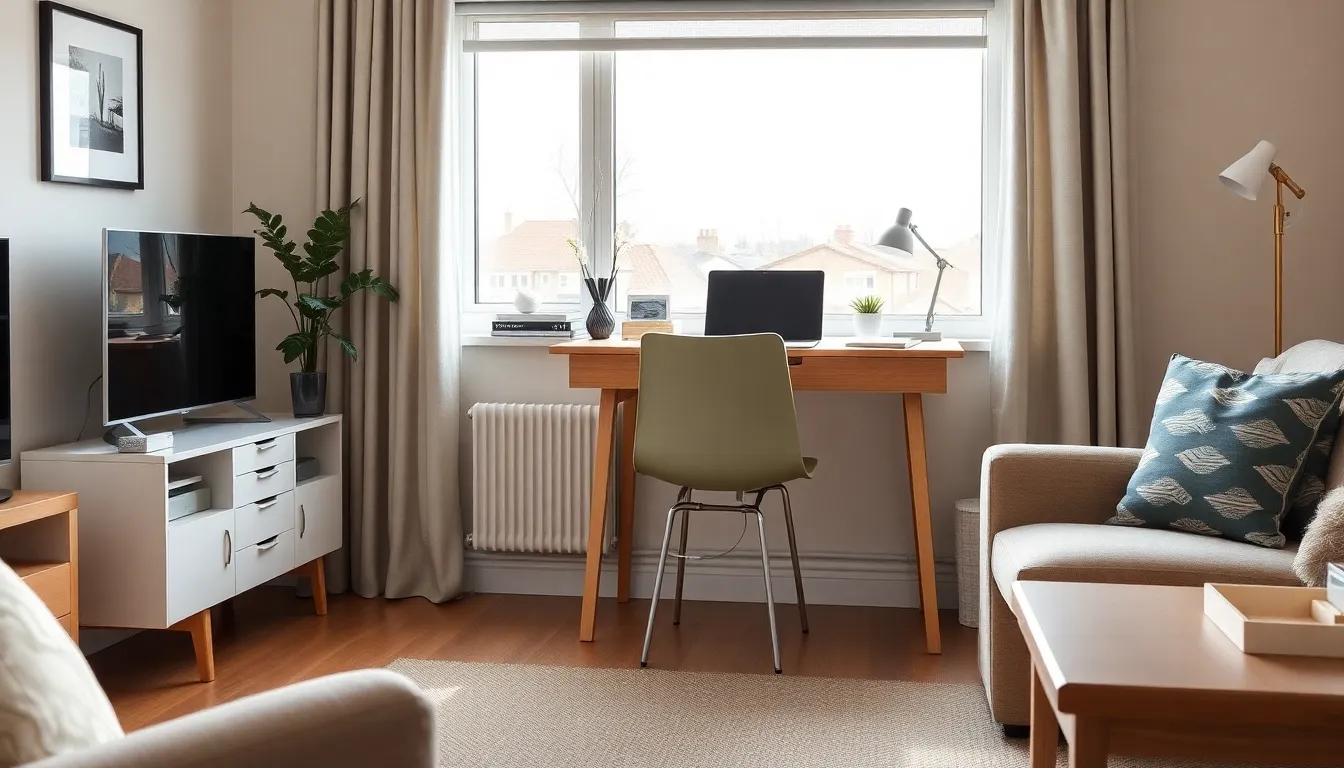
Creating a cohesive workspace within our living room requires thoughtful integration of office elements that complement rather than compete with our existing decor. We can achieve this balance by selecting pieces that serve dual purposes while maintaining visual harmony throughout the space.
Choose Furniture That Matches Your Existing Style
Secretary desks offer the perfect solution for maintaining our living room’s aesthetic while providing functional workspace. These sleek, foldable desks take advantage of vertical space and can be positioned by windows to maximize natural light while disappearing completely when we’re not working.
Compact desks like the HAUGA desk from IKEA fit seamlessly into small spaces without overwhelming our living room’s design. We can select pieces that echo our existing furniture’s materials, whether that’s warm wood tones, sleek metal finishes, or clean white surfaces.
Elegant chairs that complement our living room style prevent the workspace from feeling like an afterthought. The BJÖRKBERGET chair from IKEA provides both comfort and visual appeal, ensuring our office area enhances rather than detracts from our room’s overall design scheme.
Coordinate Office Accessories With Room Colors
Colorful accents can transform our workspace into a design feature that actively contributes to our living room’s visual appeal. We might choose transparent desks that virtually disappear into the background or select bold desk accessories that echo our existing throw pillows or artwork.
Neutral tones for office equipment help maintain a cohesive look throughout our space. We can opt for white, beige, or gray monitors, keyboards, and desk organizers that blend seamlessly with our living room’s color palette.
Strategic color coordination extends to our storage answers and desk accessories. We can choose file organizers, pen holders, and desk lamps in colors that already appear elsewhere in our living room, creating visual connections that make the workspace feel intentional rather than imposed.
Hide Cables and Tech Equipment Strategically
Cable management becomes crucial when our office shares space with our relaxation area. We can use clever storage answers like cable clips, cord organizers, and desktop grommets to keep unsightly wires hidden from view while maintaining easy access to our devices.
Strategic positioning of our tech equipment helps preserve our living room’s aesthetic appeal. We might tuck our router behind a decorative object, position our printer inside a nearby cabinet, or use a desk with built in cable management features.
Cord concealers and cable trays mounted under our desk surface keep power strips and excess cables completely out of sight. We can also use decorative baskets or boxes to hide external hard drives, chargers, and other tech accessories that aren’t in constant use.
Establish Proper Lighting for Dual-Purpose Spaces
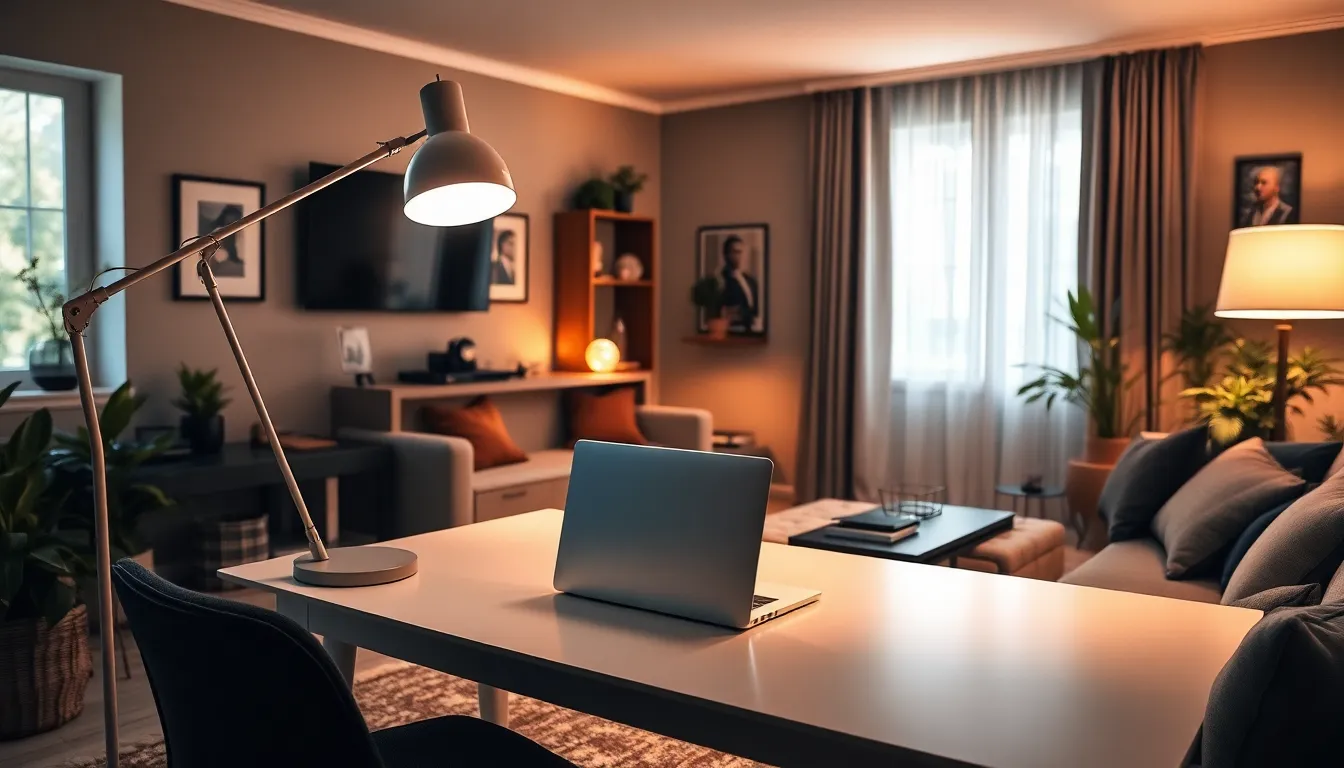
Lighting plays a crucial role in creating a functional home office within our living room. We need to carefully balance work productivity with relaxation comfort throughout different times of the day.
Add Task Lighting for Focused Work Sessions
Task lighting creates focused illumination that enhances our productivity during work hours. We should install desk lamps that provide direct light on our workspace, ensuring we can read documents and work on our computers without straining our eyes.
Adjustable desk lamps offer the flexibility we need to direct light exactly where it’s needed most. LED desk lamps work particularly well because they produce bright, white light that mimics natural daylight while consuming less energy than traditional bulbs.
Under cabinet lighting can also serve as excellent task lighting when we position our workspace near existing cabinetry. This type of lighting eliminates shadows on our work surface while maintaining the living room’s aesthetic appeal.
Balance Ambient Lighting for Evening Relaxation
Ambient lighting sets the overall mood of our dual-purpose space when we transition from work to relaxation mode. We should install dimmable overhead lights that allow us to adjust brightness levels throughout the day, creating a softer atmosphere for evening activities.
Floor lamps positioned in corners provide gentle, diffused light that helps us unwind after work hours. Table lamps on side tables or console surfaces add warmth to the space while maintaining the cozy living room atmosphere we desire.
String lights or wall sconces can create a relaxing ambiance without interfering with our workspace setup. These lighting options help us psychologically separate work time from leisure time within the same physical space.
Position Desk Lamps to Minimize Screen Glare
Screen glare can cause eye strain and reduce our work efficiency, so we must position desk lamps strategically. We should place our desk lamp to the side of our computer screen rather than directly behind or in front of it to eliminate reflections.
Left-handed workers should position their desk lamp on the right side of their workspace, while right-handed workers should place it on the left to avoid casting shadows while writing. This positioning ensures optimal lighting without creating glare on our computer screens.
Adjustable lamp arms allow us to fine-tune the light direction throughout the day as natural light conditions change. We can angle the light away from our screen while still illuminating our keyboard and documents effectively.
Organize Storage Solutions That Serve Both Functions
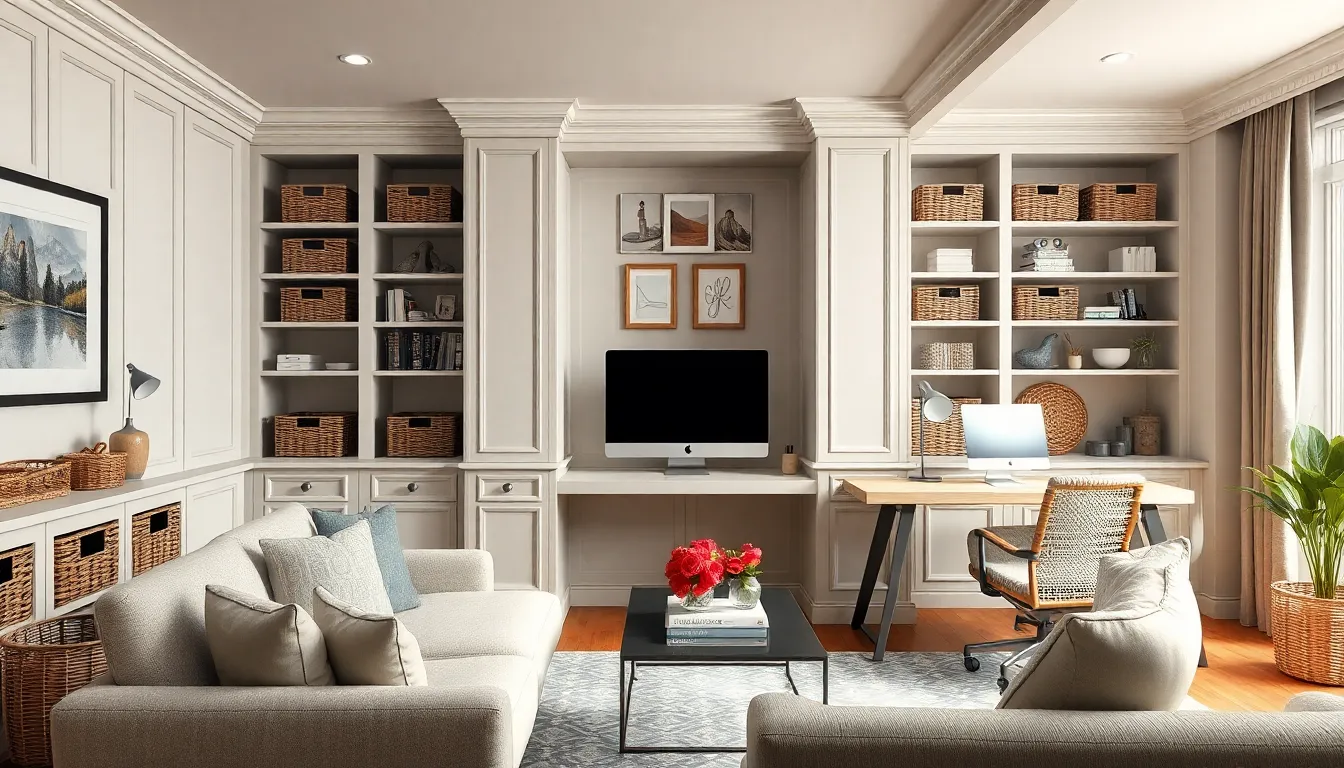
Smart storage answers transform your living room office setup by maintaining both workspace functionality and home comfort. The key lies in selecting organizational pieces that complement your existing decor while keeping essential office supplies easily accessible.
Use Decorative Baskets for Office Supply Storage
Decorative baskets blend seamlessly into living room environments while concealing office clutter from view. We recommend woven baskets in natural materials like rattan or seagrass that match coastal or bohemian decor styles. Place these storage answers on floating shelves, under console desks, or beside seating areas to keep pens, notebooks, and charging cables organized yet hidden.
Different basket sizes accommodate various office supplies effectively. Large baskets store laptop accessories, extra cables, and reference materials, while smaller ones hold paper clips, sticky notes, and business cards. Label baskets discreetly using stylish tags or small chalkboard signs to maintain organization without compromising aesthetics.
Choose baskets with handles for easy transport between your workspace and storage areas. This mobility allows you to quickly clear your desk surface when transitioning from work mode to relaxation time, maintaining the dual functionality your living space requires.
Install Built-In Cabinets for Seamless Integration
Built-in cabinets provide the most cohesive storage solution for living room offices by matching existing architectural elements. Custom cabinetry can incorporate desk surfaces, file storage, and display areas within a single unit that appears intentionally designed for the space. These installations often increase home value while maximizing storage capacity.
Floor-to-ceiling built-ins use vertical space efficiently without overwhelming smaller living rooms. We suggest incorporating both open shelving for decorative items and closed storage for office supplies, creating visual balance between work materials and personal belongings. Consider adding interior lighting to highlight decorative objects while maintaining easy access to stored items.
Cabinet doors with soft-close hinges minimize noise disruption during video calls or family activities. Select hardware finishes that coordinate with existing light fixtures and furniture accents to maintain design consistency throughout your living space.
Choose Stylish Filing Answers That Complement Decor
Filing cabinets don’t have to look like traditional office furniture when integrated thoughtfully into living room designs. Modern filing answers include lateral file cabinets that double as media consoles, storing both important documents and entertainment equipment. These pieces often feature wood finishes or painted surfaces that match existing furniture.
Rolling file carts offer flexibility for smaller spaces, allowing you to move document storage as needed while maintaining a clean aesthetic. Look for carts with fabric bins or wooden drawers that coordinate with your living room’s color palette rather than standard metal filing systems.
Credenzas with built-in file storage serve multiple purposes by providing surface space for decor, concealing office supplies, and organizing important papers. These substantial pieces anchor workspace areas while maintaining the sophisticated appearance expected in main living spaces. Choose options with adjustable shelving to accommodate both hanging files and office equipment storage needs.
Create Privacy and Focus in Shared Spaces

Working from our living room requires strategic planning to maintain concentration while family life continues around us. Research shows that thoughtful positioning and privacy answers significantly improve productivity in shared home office environments.
Use Noise-Canceling Answers for Better Concentration
Noise-canceling headphones serve as our first line of defense against household distractions during important calls and focused work sessions. White noise machines provide consistent background sound that masks sudden interruptions like conversation, television, or kitchen activities that naturally occur in shared living spaces.
Soft furnishings transform our workspace acoustics by absorbing ambient sound that bounces off hard surfaces. We can strategically place area rugs beneath our desk area, add throw pillows to nearby seating, and incorporate upholstered furniture pieces that naturally dampen noise levels throughout the room.
Plants offer dual benefits as both sound dampening elements and calming visual features that reduce stress during work hours. Large leafy plants like fiddle leaf figs or rubber trees positioned near our workspace create subtle acoustic barriers while improving air quality and adding natural beauty to our office environment.
Position Workstations Away From High-Traffic Areas
Strategic desk placement in quieter corners dramatically reduces interruptions and helps us maintain concentration during peak family activity times. We should identify the main walkways between rooms, kitchen access points, and entertainment zones to avoid positioning our workspace directly in these high-movement areas.
Corner locations naturally provide more privacy and fewer distractions since they’re removed from the central flow of household traffic. These spaces often receive less foot traffic while still maintaining connection to the room’s natural lighting and electrical outlets we need for our office equipment.
Distance from communal activity zones like television viewing areas and dining spaces creates mental separation between work and relaxation functions. Research indicates that workers positioned away from high-traffic areas report significantly better focus and fewer interruptions throughout their workday.
Add Plants or Curtains for Visual Separation
Large indoor plants create natural room dividers that separate our workspace without blocking light or making the living room feel cramped. We can use tall plants like snake plants, monstera deliciosa, or bird of paradise to establish clear visual boundaries between our office area and relaxation zones.
Curtain panels mounted on ceiling tracks provide flexible privacy options that we can adjust throughout the day based on our work needs. Sheer or semi-transparent fabrics maintain the room’s open feeling while creating subtle separation, and we can easily pull them closed during video calls or when we need maximum concentration.
Bookshelves serve dual purposes as both visual dividers and functional storage answers for our office supplies and personal items. We can position tall, narrow bookcases perpendicular to walls to create distinct zones while maintaining easy movement between areas and maximizing our living room’s versatility for both work and leisure activities.
Conclusion
Creating a functional home office within your living room doesn’t require sacrificing style or comfort. We’ve shown you that with thoughtful planning and creative answers you can establish a productive workspace that seamlessly blends with your existing decor.
The key lies in choosing versatile furniture pieces maximizing underutilized spaces and implementing smart storage answers. Whether you opt for corner workstations behind-the-sofa arrangements or wall-mounted desks each approach offers unique benefits for different living situations.
Remember that proper lighting cable management and sound control are essential elements that transform any workspace from amateur to professional. By incorporating these strategies you’ll maintain your living room’s welcoming atmosphere while boosting your work productivity and focus throughout the day.
Frequently Asked Questions
Can I create a functional home office in my living room without sacrificing style?
Yes, absolutely! You can blend productivity with comfort by choosing furniture that matches your existing decor, using multi-functional pieces like ottomans with storage, and incorporating wall-mounted solutions. The key is selecting office elements that complement your living room’s aesthetic while maintaining clear boundaries between work and relaxation zones through strategic placement and design choices.
What are the best ways to create boundaries between work and living spaces?
Room dividers, folding screens, sliding barn doors, and tall bookshelves are excellent options for creating distinct zones. These solutions maintain an open feel while providing visual separation. You can also use console tables behind sofas or position workstations in corners to naturally define work areas without overwhelming your living room’s primary function.
How can I maximize small spaces for a home office setup?
Focus on corner spaces with floating corner desks and vertical storage solutions. Use wall-mounted desks and fold-down options that preserve floor space. Multi-functional furniture like nesting tables and console tables provide flexible workspace options. These strategies help you create an efficient office setup even in the smallest living rooms.
What lighting considerations are important for a living room office?
You need both task lighting for productivity and ambient lighting for relaxation. Use adjustable desk lamps positioned to minimize screen glare, under-cabinet lighting to eliminate shadows, and dimmable overhead lights. This combination ensures optimal lighting for work hours while maintaining a cozy atmosphere for evening leisure activities.
How do I manage storage without cluttering my living space?
Use decorative baskets for office supplies, built-in cabinets for cohesive storage, and stylish filing options like lateral file cabinets. Wall-mounted shelving keeps essentials accessible without cluttering surfaces. Choose storage solutions that blend with your living room decor, ensuring functionality while maintaining visual appeal and organization.
What strategies help minimize distractions when working in shared spaces?
Position your workstation away from high-traffic areas and use noise-canceling headphones or white noise machines. Soft furnishings like area rugs and upholstered furniture help absorb sound. Plants and curtains can provide visual separation while maintaining light and openness. Strategic planning of your workspace location is crucial for maintaining focus.







